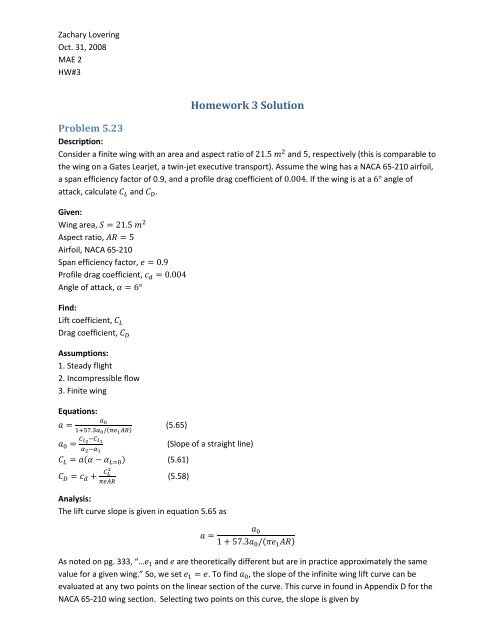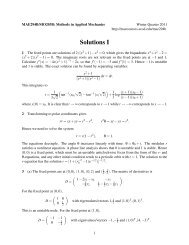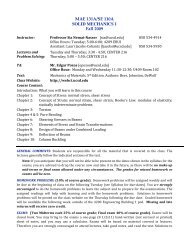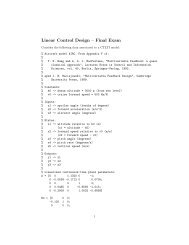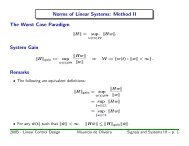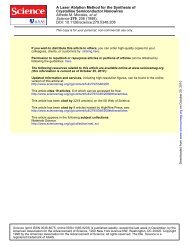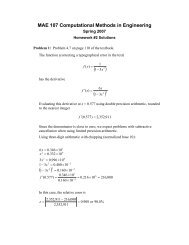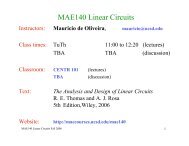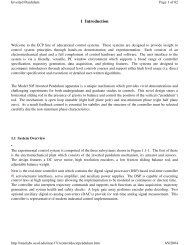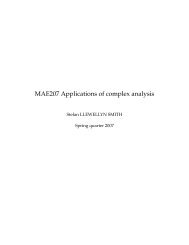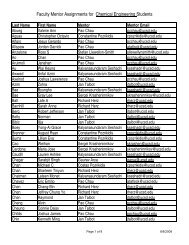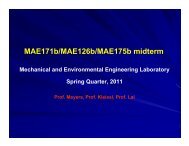HW3 Solution
HW3 Solution
HW3 Solution
You also want an ePaper? Increase the reach of your titles
YUMPU automatically turns print PDFs into web optimized ePapers that Google loves.
Zachary Lovering<br />
Oct. 31, 2008<br />
MAE 2<br />
HW#3<br />
Homework 3 <strong>Solution</strong><br />
Problem 5.23<br />
Description:<br />
Consider a finite wing with an area and aspect ratio of 21.5 and 5, respectively (this is comparable to<br />
the wing on a Gates Learjet, a twin-jet executive transport). Assume the wing has a NACA 65-210 airfoil,<br />
a span efficiency factor of 0.9, and a profile drag coefficient of 0.004. If the wing is at a 6° angle of<br />
attack, calculate and .<br />
Given:<br />
Wing area, 21.5 <br />
Aspect ratio, 5<br />
Airfoil, NACA 65-210<br />
Span efficiency factor, 0.9<br />
Profile drag coefficient, 0.004<br />
Angle of attack, 6°<br />
Find:<br />
Lift coefficient, <br />
Drag coefficient, <br />
Assumptions:<br />
1. Steady flight<br />
2. Incompressible flow<br />
3. Finite wing<br />
Equations:<br />
<br />
<br />
. / (5.65)<br />
(Slope of a straight line)<br />
(5.61)<br />
<br />
(5.58)<br />
Analysis:<br />
The lift curve slope is given in equation 5.65 as<br />
<br />
<br />
1 57.3 / <br />
As noted on pg. 333, “… and are theoretically different but are in practice approximately the same<br />
value for a given wing.” So, we set . To find , the slope of the infinite wing lift curve can be<br />
evaluated at any two points on the linear section of the curve. This curve in found in Appendix D for the<br />
NACA 65-210 wing section. Selecting two points on this curve, the slope is given by
Additionally, from this same curve, the angle of attack at zero lift, , can be found. With these values<br />
known, the finite wing lift coefficient, , is given in equation 5.61 as,<br />
<br />
<br />
<br />
1 57.3 /<br />
The finite wing drag coefficient is given in equation 5.58 as,<br />
<br />
<br />
Since is known and is simply the profile drag, can be found.<br />
Numerical Substitution:<br />
Selecting the following two points on the linear portion of the lift slope curve for the NACA 65-210<br />
airfoil,<br />
Next the slope is calculated to be,<br />
Using the equation for found in the analysis,<br />
Using the equation for found in the analysis,<br />
1.05 at 8°<br />
0 at 1.5°<br />
1.05 0<br />
<br />
8° 1.5°<br />
1.05<br />
9.5°<br />
0.11 <br />
0.11<br />
<br />
1<br />
6° 1.5°<br />
<br />
57.3 0.11<br />
1 <br />
1<br />
<br />
0.95<br />
0.825<br />
1.4458<br />
0.57<br />
0.004 0.57<br />
0.95<br />
0.027
Problem 5.26<br />
Description:<br />
Consider a light, single-engine airplane such as the Piper Super Cub. If the maximum gross weight of the<br />
airplane is 7780 , the wing area is 16.6 , and the maximum lift coefficient is 2.1 with flaps down,<br />
calculate the stalling speed at sea level.<br />
Given:<br />
Gross weight, 7780 <br />
Wing area, 16.6 <br />
Maximum lift coefficient, , 2.1<br />
Find:<br />
Stalling speed, <br />
Assumptions:<br />
1. Sea level<br />
2. Steady level flight<br />
Equations:<br />
<br />
<br />
,<br />
(5.71)<br />
Analysis:<br />
The stalling speed may be calculated using equation 5.71.<br />
Numerical Substitution:<br />
Sea level density is found in Appendix A as,<br />
Using the equation from the analysis,<br />
<br />
<br />
2<br />
, 1.225 <br />
<br />
27780 <br />
1.225 <br />
16.6 2.1<br />
15560 · <br />
<br />
42.7035 <br />
<br />
19.1
Problem 9.4<br />
Description:<br />
Consider a turbojet-powered airplane flying at a standard altitude of 40000 at a velocity of 530 /<br />
. The turbojet engine has an inlet and exit areas of 13 and 10 , respectively. The velocity and<br />
pressure of the exhaust gas at the exit are 1500 / and 450 / , respectively. Calculate the thrust<br />
of the turbojet.<br />
Given:<br />
Standard altitude, 40000 <br />
Air speed, 530 /<br />
Inlet Area, 13 <br />
Exit Area, 10 <br />
Exhaust velocity, 1500 /<br />
Exhaust pressure, 450 / <br />
Find:<br />
Thrust, <br />
Assumptions:<br />
1. Steady flow<br />
2. Conditions at the inlet are the free stream conditions<br />
Equations:<br />
(9.25)<br />
<br />
Analysis:<br />
Using the thrust equation (Eq. 9.25),<br />
<br />
To solve for the air mass flow rate, , the continuity equation is used.<br />
<br />
Substituting the continuity equation into the thrust equation yields,<br />
<br />
where and are found from Appendix A at the altitude of 40000 .<br />
Numerical Substitution:<br />
At a standard altitude of 40000 , from Appendix A it is found that<br />
393.12 <br />
<br />
5.8727 · 10<br />
The velocity must be converted into consistent units,
530 <br />
<br />
777 <br />
<br />
Using the equation for thrust found in the analysis,<br />
Note that,<br />
5.8727 · 10<br />
<br />
1 <br />
5280 <br />
1 3600 <br />
<br />
777<br />
13 1500 <br />
<br />
450 393.12 10 · <br />
4289 567 4858 <br />
<br />
· <br />
<br />
<br />
777
Problem 9.6<br />
Description:<br />
A small ramjet engine is to be designed for a maximum thrust of 1000 at sea level at a velocity of<br />
950 /. If the exit velocity and pressure are 2000 / and 1.0 , respectively, how large should<br />
the inlet be?<br />
Given:<br />
Maximum thrust, 1000 <br />
Air velocity, 950 /<br />
Exit velocity, 2000 /<br />
Exit pressure, 1.0 <br />
Find:<br />
Inlet area, <br />
Assumptions:<br />
1. Sea level<br />
2. Steady flow<br />
3. Conditions at the inlet are the free stream conditions<br />
Equations:<br />
(9.25)<br />
<br />
Analysis:<br />
Using the thrust equation (Eq. 9.25),<br />
<br />
Since the air pressure ahead of the engine, , and exit pressure, , are equal, the thrust equation<br />
reduces to,<br />
Finally, substituting in the continuity equation,<br />
and solving for yields,<br />
<br />
<br />
<br />
<br />
Numerical Substitution:<br />
The density at sea level is 0.002377 / . Using the equation found for inlet area from the<br />
analysis,<br />
1000 <br />
0.002377 <br />
950<br />
<br />
2000<br />
<br />
950
· <br />
1000<br />
<br />
2371 <br />
· 0.42
Problem 9.16<br />
Description:<br />
For the turbojet engine operating under the conditions given in Example 9.3, calculate the propulsive<br />
efficiency, as defined in Prob. 9.15.<br />
Given:<br />
Air velocity, 500 /<br />
Exhaust velocity, 1600 /<br />
Find:<br />
The propulsive efficiency, <br />
Assumptions:<br />
1. Steady flow<br />
2. Thrust from pressure difference is negligible<br />
3. Conditions at the inlet are the free stream conditions<br />
Equations:<br />
<br />
<br />
/ <br />
Analysis:<br />
The propulsive efficiency was defined in Problem 9.15 as,<br />
Numerical Substitution:<br />
Converting the air velocity to consistent units,<br />
Using the equation from the analysis,<br />
500 <br />
<br />
733.33 <br />
<br />
2<br />
<br />
1 / <br />
1 <br />
5280 <br />
1 3600 <br />
2<br />
<br />
<br />
1600<br />
1 <br />
733.33 <br />
<br />
<br />
2<br />
3.1818<br />
0.63


